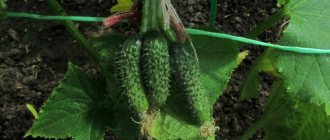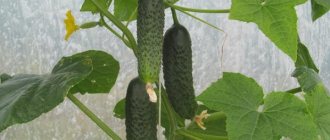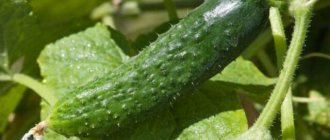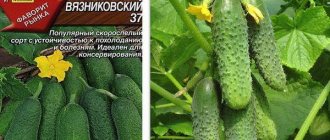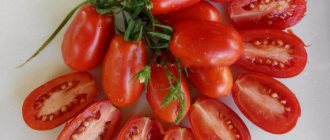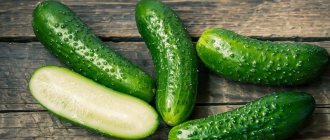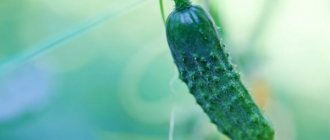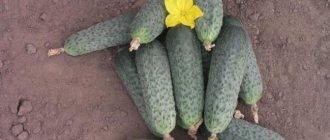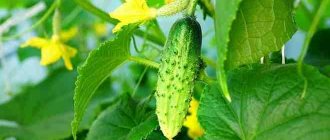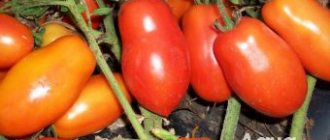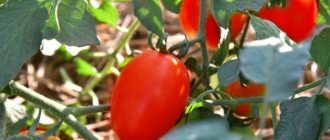Vegetable growing » Cucumbers
0
1769
Article rating
Kira Stoletova
Beginning summer residents and even professionals are looking for new varieties of vegetable crops every new season that can satisfy all requirements. The assortment of modern cucumbers is huge, which complicates the selection process. Agronomists who specialize in growing this crop advise paying attention to the Octopus cucumber variety and its characteristics.
Characteristics of Octopus cucumbers
Description of Octopus cucumbers
Cucumber Octopus f1 is a bee-pollinated hybrid. The plants are small in size with thick stems and pentagonal leaves. They bear fruit in small groups of 4-5 pieces. Cucumber weight is from 70 to 90 grams. The cucumber itself has a bright green color, the fruits, unlike the Chinese miracle cucumber variety, are small 5-9 cm, large-tubercular, regular cucumber-shaped, without bitterness.
The cucumber is tasty, juicy and crispy. Its fruits are consumed fresh and frozen, and used for pickling. The variety is also grown for sale.
The plant has a female flowering type, mid-season - fruits appear on the 40-50th day. The Octopus f1 cucumber variety produces a harvest for a very long time: in dry and warm autumn in open ground it can bear fruit until the end of October, while the plant does not get sick, and the cucumber remains just as bright and tasty. This variety must be grown outdoors because it needs bee pollination.
Description and characteristics of the variety
Octopus F1 is a bee-pollinated hybrid for growing in film shelters and open ground. Its bushes are medium in size, with pentagonal dissected leaves and powerful stems. The fruits are formed in small bunches of 3-4 pieces. In terms of ripening time, the cultivar is medium early - the harvest appears on the 45-48th day after germination.
Zelentsy reach 6-9 cm in length, neat, oval in shape, weighing 50-70 g. The shape is slightly ribbed. There are large tubercles on the skin. The pubescence is white, the spines are light, but may be completely absent. The pulp is juicy, crispy, aromatic. The fruits are used for pickling, fresh consumption and freezing, and are grown for sale.
To preserve the harvest longer, it is kept in the refrigerator at a temperature of +3-8 degrees.
Pros and cons of the variety
Octopus is endowed with many advantages, thanks to which gardeners appreciate the variety.
pros
Description of the positive characteristics of the variety:
- excellent taste of fruits;
- neat shape;
- high productivity;
- unpretentiousness;
- mid-ripening;
- cucumber tolerates drought and high atmospheric temperatures well;
- the variety is resistant to many diseases;
- Cucumber is great for both pickling and pickling.
Minuses
- You cannot harvest cucumber seeds.
Octopus - a variety of cucumber plant
Variety characteristics:
Properties of the Octopus variety:
Recommended region on the map:
Information on the admission of Cucumber Octopus from the Register of the State Variety Commission of the Russian Federation
Application for admission No. 29682, registered 1996-04-04. The Cucumber Octopus variety was included in the register of approved varieties in 1998. Approved for use in the regions: Central, Middle Volga, West Siberian.
The originator of the Octopus Cucumber variety is:
- SYNGENTA SEEDS BV (WESTEINDE 62, PO BOX 2, 1600 AA ENKHUIZEN THE NETHERLANDS)
Other plant varieties Cucumber
Search for variety by name
Variety selection
Question to the portal experts
If you haven't found the answer to a question, don't hesitate to ask an expert.
Register or Login so you don't have to enter your Name and Email every time
Thanks for the comment! It will be published after checking by a moderator!
No comments yet, be the first!
A portal for those who love their dacha
Your question has been sent for moderation. Don't worry, we quickly check your questions and your question will be answered within 1 day.
We have noticed that you are already registered on our website. We recommend that you log in to view the question you created. If you don't remember your password, you can recover it.
You were not registered until today, so we have registered you. Your password has been sent to your specified mailbox.
Help our site develop!
Please read this message, it will not take up much of your time!
We so need your comments and questions to understand in which direction we should develop.
Don't forget to leave a comment if you found what you were looking for. And if you haven’t found it, use the “Ask an Expert” form in the site header. We will answer this question, and other visitors will be able to find the information that you could not find.
Sincerely, team of the portal Dacha-Dacha.ru
Your question has been sent for moderation. Don't worry, we quickly check your questions and your question will be answered within 1 day.
We have noticed that you are already registered on our website. We recommend that you log in to view the question you created. If you don't remember your password, you can recover it.
You were not registered until today, so we have registered you. Your password has been sent to your specified mailbox.
Landing Features
Octopus f1 is recommended to be grown in open ground both by seedlings and by sowing seeds.
Landing dates
About 30 days before planting, the seeds must be heated at a temperature of 30-35 degrees. This procedure helps disinfect the seeds and improve their germination. Due to the strong influence of temperature, harmful organisms die, and the seed awakens and germinates faster when planted.
Seedlings grow in about 27-30 days. You can calculate the day of sowing seeds from the date of transplanting seedlings into open ground. Each person will have their own planting time, as growing zones are different. For example, if you plant cucumber seedlings on May 10, then you need to plant seeds for good seedlings on April 10, and you need to start warming up the seeds on March 10.
Site preparation
Description of how to choose a plot for cucumbers:
- Over the past 3 years, pumpkins, melons, cucumbers, and zucchini must not have been grown on the land.
- The best predecessors for the plant are tomatoes, onions, peas, peppers, beans, and potatoes.
- The land should be on a hill.
- A lot of light is needed where cucumbers are planted.
- Soil acidity – pH 6-7.
In order for Octopus to bear fruit well, it is necessary to dig up the soil in the fall and fertilize it with organic matter.
Planting seeds
It is not recommended to plant seeds in large trays. It will be difficult to replant a cucumber without damaging the root. The best option for growing seedlings is special peat containers. Seedling cups need to be filled with soil mixture. However, not every soil will allow a cucumber to survive and grow. It is advisable to make the soil yourself.
Description of the best soil options for cucumbers of the Octopus f1 variety:
- Combine 50% humus and 50% black peat.
- Mix 30% turf, 30% humus, 30% peat and 10% aged sawdust.
- Collect 30% peat, 50% humus and 20% rotted sawdust.
When the soil is ready, you need to distribute the seeds on the surface of the ground and cover no more than 1-2 cm with the mixture. When watering, the seeds may sink to the bottom, so it is recommended to simply spray the ground with water and cover it with film. The variety will grow faster.
Octopus loves light, so it is important to monitor the lighting. To prevent the variety from stretching out after germination, it needs to be illuminated around the clock for three days.
To ensure that the cucumber does not suffer in the open ground from disease-carrying pests, you need to properly prepare the soil. It is necessary to water the soil in the seedling pots to prevent mites or aphids 4-5 days before transplanting the seedlings. For this purpose, Apache or Actar solutions are used.
After planting the seeds, the thermometer should be at 25-29 degrees. As soon as the cucumber sprouts, set the temperature to 20 degrees. If the shoots begin to stretch, lower it to 15. This is the minimum temperature when growing cucumbers.
Planting seedlings
Important: the Octopus f1 variety cannot be transplanted into the ground if it has not warmed up to a temperature of 15 degrees to a depth of 11 cm. The cucumber will die.
When transplanting seedlings, first make a hole, fill it with fertilizer, then immerse the cucumber. Preparations containing calcium, magnesium, boron and potassium are used as fertilizers.
Planting scheme
The Octopus f1 cucumber variety is planted in the second half of May - early June. A lot of space is left between the seedlings as Octopus grows quickly. The best distance will be 30-45 cm. There should be at least 60 cm between rows. You cannot plant more than 3 bushes per 1 sq. m. Planting depth is 2-4 cm. Seeds are sown according to the pattern 70 by 30 cm or 90 by 30 cm.
Buy cucumber seeds Octopus F1 (Syngenta) at the Seed Supermarket
Octopus F1 is an early hybrid of a bee-pollinated gherkin-type cucumber, in which the fruiting period begins in the 40th day.
The fruit is cylindrical, short and coarsely tuberculate, rich green, not bitter. In one node, 2-3 ovaries are formed.
Long fruiting period. Tolerates high air temperatures well.
Intended for fresh sale, pickling and salting. The color of the fruit does not change during long-term storage and transportation.
Cucumber Octopus F1 is a participant in the following ratings in the magazines of the Seed Supermarket:
- review of popular bee-pollinated cucumbers for open ground, No. 3 “Summer 2015”, p. 24;
- review of the best cucumbers for pickling, No. 5 “Spring 2016”, p. 35.
Octopus F1 Syngenta cucumber seeds can be in two types of packaging:
- original (from the manufacturer);
- from the Seeds Supermarket.
If you only need seeds in original packaging, please indicate this in the comments to your order or tell the sales consultant this when placing your order by phone.
The manufacturer reserves the right to change the packaging design, color and availability of seed treatment.
If this item does not have a package with a suitable number of seeds, please inform our sales manager - he will try to help you open the package or offer a suitable analogue.
- 8
Variety: HybridRipening period: Ultra earlyType: ParthenocarpicFruit type: short-fruited up to 14cm
- 8
Variety: HybridRipening period: Ultra earlyType: ParthenocarpicFruit type: short-fruited up to 14cm
- 6
Variety: HybridRipening period: EarlyType: Bee-pollinatedFruit type: short-fruited up to 14cm
- 6
Variety: HybridRipening period: EarlyType: ParthenocarpicFruit type: short-fruited up to 14cm
- 5
Variety: HybridRipening period: Ultra earlyType: ParthenocarpicFruit type: short-fruited up to 14cm
- 5
Variety: HybridRipening period: EarlyType: ParthenocarpicFruit type: short-fruited up to 14cm
- 4
Variety: HybridRipening period: Ultra earlyType: ParthenocarpicFruit type: short-fruited up to 14cm
- 3
Variety: HybridRipening period: EarlyType: ParthenocarpicFruit type: short-fruited up to 14cm
- 3
Variety: HybridRipening period: EarlyType: ParthenocarpicFruit type: short-fruited up to 14cm
- 3
Variety: HybridRipening period: EarlyType: ParthenocarpicFruit type: short-fruited up to 14cm
- 3
Variety: HybridRipening period: Ultra earlyType: ParthenocarpicFruit type: short-fruited up to 14cm
- 3
Variety: HybridRipening period: EarlyType: ParthenocarpicFruit type: short-fruited up to 14cm
- 2
Variety: HybridRipening period: EarlyType: ParthenocarpicFruit type: short-fruited up to 14cm
- 2
Variety: HybridRipening period: EarlyType: Bee-pollinatedFruit type: short-fruited up to 14cm
- 2
Variety: HybridRipening period: EarlyType: ParthenocarpicFruit type: short-fruited up to 14cm
- 2
Variety: HybridRipening period: EarlyType: ParthenocarpicFruit type: short-fruited up to 14cm
- 2
Variety: HybridRipening period: Ultra earlyType: ParthenocarpicFruit type: short-fruited up to 14cm
- 2
Variety: HybridRipening period: Ultra earlyType: ParthenocarpicFruit type: short-fruited up to 14cm
- 2
Variety: Hybrid Ripening period: Mid-season Type: Parthenocarpic Fruit type: short-fruited up to 14 cm
- 2
Variety: HybridRipening period: Ultra earlyType: ParthenocarpicFruit type: short-fruited up to 14cm
- 2
Variety: HybridRipening period: EarlyType: Bee-pollinatedFruit type: short-fruited up to 14cm
- 2
Variety: HybridRipening period: EarlyType: ParthenocarpicFruit type: short-fruited up to 14cm
- 2
Variety: HybridRipening period: EarlyType: ParthenocarpicFruit type: short-fruited up to 14cm
- 2
Variety: HybridRipening period: EarlyType: ParthenocarpicFruit type: Medium-fruited 14-25cm
- 2
Variety: HybridRipening period: EarlyType: ParthenocarpicFruit type: short-fruited up to 14cm
- 2
Variety: Variety Ripening period: Mid-late Type: Bee-pollinated Fruit type: short-fruited up to 14 cm
- 2
Variety: HybridRipening period: EarlyType: ParthenocarpicFruit type: short-fruited up to 14cm
- 2
Variety: Variety Ripening period: Mid-early Type: Parthenocarpic Fruit type: Long-fruited from 25 cm Shape: Asian
- 1
Variety: HybridRipening period: EarlyType: ParthenocarpicFruit type: short-fruited up to 14cm
- 1
Variety: HybridRipening period: EarlyType: Bee-pollinatedFruit type: short-fruited up to 14cm
- 1
Variety: VarietyRipening period: EarlyType: Bee pollinated
Fruit type: short-fruited up to 14cm
- 1
Variety: HybridRipening period: EarlyType: ParthenocarpicFruit type: short-fruited up to 14cm
- 1
Variety: HybridRipening period: EarlyType: Bee-pollinatedFruit type: Medium-fruited 14-25cmForm: Beit Alpha type
- 1
Variety: HybridRipening period: EarlyType: ParthenocarpicFruit type: short-fruited up to 14cm
- 1
Variety: HybridRipening period: EarlyType: Bee-pollinatedFruit type: short-fruited up to 14cm
Quite often, before making a purchase, our customers turn to our sales consultants for help in order to get advice on choosing the right cucumber seeds. Our consultants will not refuse to help any client, whether he needs to buy cucumber seeds wholesale or retail - it doesn’t matter.
Next, we want to offer you a couple of small recommendations when choosing cucumber varieties if you decide to try planting this crop for the first time. We hope that our recommendations will not be completely useless and will help you with further purchases.
Ripening time:
– early varieties of cucumbers – expect harvest on 32-40 days, friendly fruit yield;
– medium varieties (40-50 days);
– late varieties of cucumbers (ripening time 50 days or more). Characterized by higher resistance to diseases.
There are also mid-early and mid-late intermediate varieties.
Depending on where you are going to plant cucumber seeds, they are divided into:
– cucumber seeds for open ground;
– cucumber seeds for greenhouses and film shelters (for closed ground).
According to the type of pollination, cucumbers are divided into:
– bee-pollinated, which form the ovary only with the help of insects;
– parthenocarpic (or self-pollinating) do not need the help of insects.
They also sometimes ask for the seeds of cucumbers and gherkins. Gherkins are not a type of cucumber, but a size. Gherkins are large cucumbers, and pickles are small.
You also need to consider for what purpose you are growing cucumbers, for sale or for yourself. According to their purpose, they can be divided into salad, universal and pickling varieties of cucumber.
Pickling cucumbers have black spines, while salad varieties have white spines. The main difference between pickling cucumbers and salad cucumbers is the thickness of the peel.
The former have a thinner skin, so they are suitable for salting, but are completely unsuitable for storage.
Care
Cucumber is a fastidious vegetable, especially when it comes to humidity. To create comfortable conditions for it, you need to follow the watering rules.
Watering
At high temperatures, Octopus needs to be watered twice a day. Best time: morning and evening. Octopus also loves being sprayed with warm water.
At low temperatures, watering is reduced. Excess moisture reduces growth and the cucumber can become infected with fungus. Cucumbers do not like cold water; after such watering, the number of fruits may decrease.
Garter and bush formation
The Octopus f1 cucumber variety grows quite quickly and requires plant formation, which is carried out by pinching, when excess growing vines are cut off.
Description of the advantages of proper formation of Octopus bushes:
- increased yield;
- saving land;
- reducing the possibility of contracting the disease;
- facilitating fruit harvesting.
To form bushes, a garter is required, which serves as a support for the plant, and the cucumber keeps the stem from breaking.
Top dressing
Description of the necessary regular feeding of cucumbers of the Octopus f1 variety:
- The first fertilizing is done at the beginning of plant flowering. A solution is made: for 10 liters of water, take 1 teaspoon of superphosphate, urea and potassium sulfate. Mix everything and add 1 tablespoon of sodium humate.
- During fruiting, fertilizing is done 4 times. First feeding: for 10 liters of water, 1 tablespoon of nitrophoska and 1 tablespoon of sodium humate. For other feedings: 10 liters. water 1 teaspoon of potassium sulfate and 1 teaspoon of sodium humate. For 1 sq. m will need 4-6 liters of solution.
Hilling
Hilling cucumbers is a necessary technique to increase the productivity of the crop, as well as increase the fruiting period. This procedure must be carried out with care, without damaging the root system of the plant.
First you need to water the cucumber, since dry hilling is prohibited. Then take a scraper and loosen the soil 3-5 cm, no deeper, otherwise you can damage the root, which recovers in 6 to 10 days, slowing down the growth of the cucumber. Hilling is carried out when the bed is watered. About once every 2 weeks.
Cucumber Octopus: variety description, reviews
Beginning summer residents and even professionals are looking for new varieties of vegetable crops every new season that can satisfy all requirements.
The assortment of modern cucumbers is huge, which complicates the selection process. Characteristics of Octopus cucumbers
https://www.youtube.com/watch{q}v=MzJ48nCY6F4
Octopus f1 is a bee-pollinated variety of Dutch selection. Produced by the Dutch company Sengenta. Which has established itself as a reliable producer of high-quality seed material.
The variety has a mid-early ripening period. The harvest can be harvested in 43-48 days. It has a long fruiting period, which ensures high productivity. 50-65 tons of cucumbers ripen on one hectare.
Suitable for cultivation in open ground and greenhouses. The variety is resistant to high temperatures and drought, which allows it to be grown in all regions of the middle zone. Used for industrial cultivation.
Octopus is universally used, suitable for fresh and canned consumption. Has high taste characteristics.
Description of the bush
The bush is medium-sized with well-developed central and lateral stems. The leaves are rounded-pentagonal in shape, large and medium in size, with clear, slightly dissected edges. The color of the leaf blade is green with a clear vein pattern. 3-4 fruits are formed per internode.
Description of the fruit
Fruits are gherkin type, small in size. The cucumber grows up to 8 cm long with an average weight of 50-70 grams. The proportional ratio of length to width is 3:1. They have a neat shape and high-quality presentation.
Fruit characteristics:
- dense green skin;
- smooth cylindrical shape;
- the tuberosity is large;
- there are no thorns;
- the ribbing of the surface is visible;
- the flesh is dense, crispy;
- The seed box is small, the seeds are small.
Cucumbers of this variety are ideal for supplying the fresh produce market. Collected fruits are stored well at a temperature of 3-8 °C
Sowing seeds
Nutritious soils with a pH level of 5.5-7 are suitable for this variety. The bed for planting Octopus should be well loosened and carefully prepared.
Sow seeds as seedlings or directly into the ground. Sowing of seedlings is carried out starting in mid-April and at the age of 25-30 the seedlings are transplanted into a greenhouse or open ground. The optimal time for planting is mid-May, when the soil temperature reaches 15°C and night frosts no longer threaten young plants.
At the same time, tomatoes are sown directly into the ground without seedlings. It must be remembered that cucumber seeds do not germinate at temperatures below 12 °C and may die.
The density should not be more than 3 plants per 1 square meter.
We invite you to read: Valerian officinalis - description and application
Top dressing
The plant needs fertilizer
To ensure full growth, development and fruiting, cucumbers will need fertilizing.
During the growing season, it is enough to carry it out three times.
- 2 weeks after planting in the ground or emergence of seedlings. Use complex fertilizer for pumpkin crops. Suitable soluble balanced fertilizers (Master, Kemira, Viva). Apply instructions accordingly.
- At the beginning of flowering, the bushes are sprayed with a solution of urea (5 g per 10 liters of water), and a week later with a drug to stimulate the ovary (Ovary, Phytocarpin, Boroplus).
- 14 days after the previous one, spray with urea or complex chelate fertilizer (Plantafol, Clean Sheet).
In order for the bushes to grow well, fruits to set, and the harvest to reach maximum levels, watering must be regular and correct.
On hot days, the bushes are watered twice a day. The best time to water will be morning and evening. Spraying with clean water also has a beneficial effect on plants.
On cool days, watering should be reduced. Excess moisture has a bad effect on the growth of cucumbers and leads to the development of fungal diseases. You should also not water with cold water; this is unacceptable for cucumbers.
Pests and diseases
The Octopus variety, as described, is resistant to the following diseases:
- powdery mildew;
- cladospora blight;
- cucumber mosaic.
Requires preventive treatments against fusarium and paresporosis. To protect against these diseases, every 10 days the bushes are sprayed with Trichodermin, Fitosporin or other biofungicides and enzymes. They are eco-friendly and protect bushes well from fungal diseases.
Plants may be damaged by pests, especially if the summer is hot and dry. Aphids and spider mites can be found on bushes. These are parasitic pests that deplete cucumbers and can prevent them from developing to their full potential.
What to process
Recommended preparations for treating cucumbers against pests:
- Insecticides: Mospilan, Aktelik.
- Bioinsecticides: Bioreid, Actofit.
- Folk remedies: onion peels, garlic peels, tobacco dust, ash.
https://www.youtube.com/watch{q}v=xUtDgrHNUPs
Octopus F1 cucumbers – Seeds and seedlings buy at the best pricesCucumber Amur F1: brief characteristics of the hybrid and photoEkol F1 parthenocarpic cucumber (Syngenta)
All these products show their effectiveness in controlling garden pests on cucumbers and can easily cope with them.
Conclusion
By choosing Octopus f1 for growing in a greenhouse or open ground, you can get a good harvest from a small garden bed for a long time. And the taste of fresh hand-grown cucumbers will delight even the most fastidious gourmet.
This variety will not disappoint with its characteristics even gardening professionals who have practice in growing a variety of cucumbers for industrial purposes.
Diseases and parasites
Let's look at the most common diseases and pests and methods to combat them.
Fusarium
Fusarium is also called dry rot. It is essentially an infection caused by the fungus Fusarium oxysporum. Its spores spread through the soil and are carried by wind and water, infecting plants and causing them to wilt. After removing the infected plant, you need to spray the good seedlings and the ground itself with a solution of potassium permanganate, sprinkle the top of the cucumber with ash and powdered sulfur.
To protect Octopus from fusarium, you need to take care of this before planting. After sowing seeds or planting seedlings, you need to spray them against rot with special preparations based on phosphorus and potassium.
Downy mildew
A common disease that appears as dry yellow or brown spots. Downy mildew, or downy mildew, is a fatal fungal disease that damages the leaf tissue of cucumber varieties. Photosynthesis processes in the tops are disrupted, and they begin to rapidly turn yellow. In the absence of adequate measures, Octopus can die in 7–10 days.
To prevent infection, it is enough to spray the plants with phytosporin once every 10 days.
Spider mites and aphids
Dangerous pests of vegetable crops are spider mites and aphids. Their presence is immediately visible. Small yellow dots appear on the leaves of Octopus, a cobweb forms on the back of the leaf, and the leaves of the variety begin to curl and dry out. Octopus is saved by folk remedies: ash, onion and garlic peels, tobacco dust.
Growing and care
Top dressing
Three feedings per season are required:
- 14 days after germination of seeds in open ground or transfer of seedlings there (use a complex product such as Kemira-Lux or Viva);
- At the beginning of flowering, spray the leaves with a solution of 5 g of urea in a bucket of water;
- After two weeks - a complex preparation in chelate form or repeated spraying with a urea solution.
Cucumbers, especially at the beginning of development, require nitrogen, which is contained in organic fertilizers. The first feeding can be replaced by watering with mullein solution (1 liter per 10 liters of water).
Watering
In hot weather, water the bushes daily, otherwise 2-3 times a week. Use warm and settled water; watering is carried out in the evening.
In addition, the soil is carefully loosened and the bushes are tied to supports.
Harvesting and storage
The cucumber variety Octopus f1 bears fruit well. Literally from 1 sq. m. you can harvest up to 15 kg of cucumbers. Fruits can be collected either manually or mechanically. This variety of cucumbers is easily transported and stored for a long time.
Cucumber does not lose its color brightness during long-term storage. Favorable temperature for storage is 3-8 degrees. Octopus f1 is an excellent variety of cucumbers. It will delight everyone with its appearance, taste and harvest.

